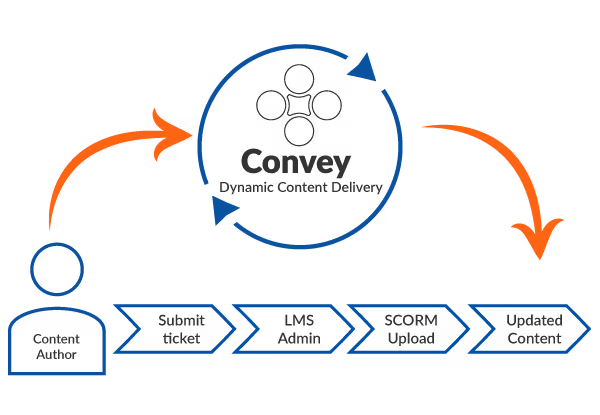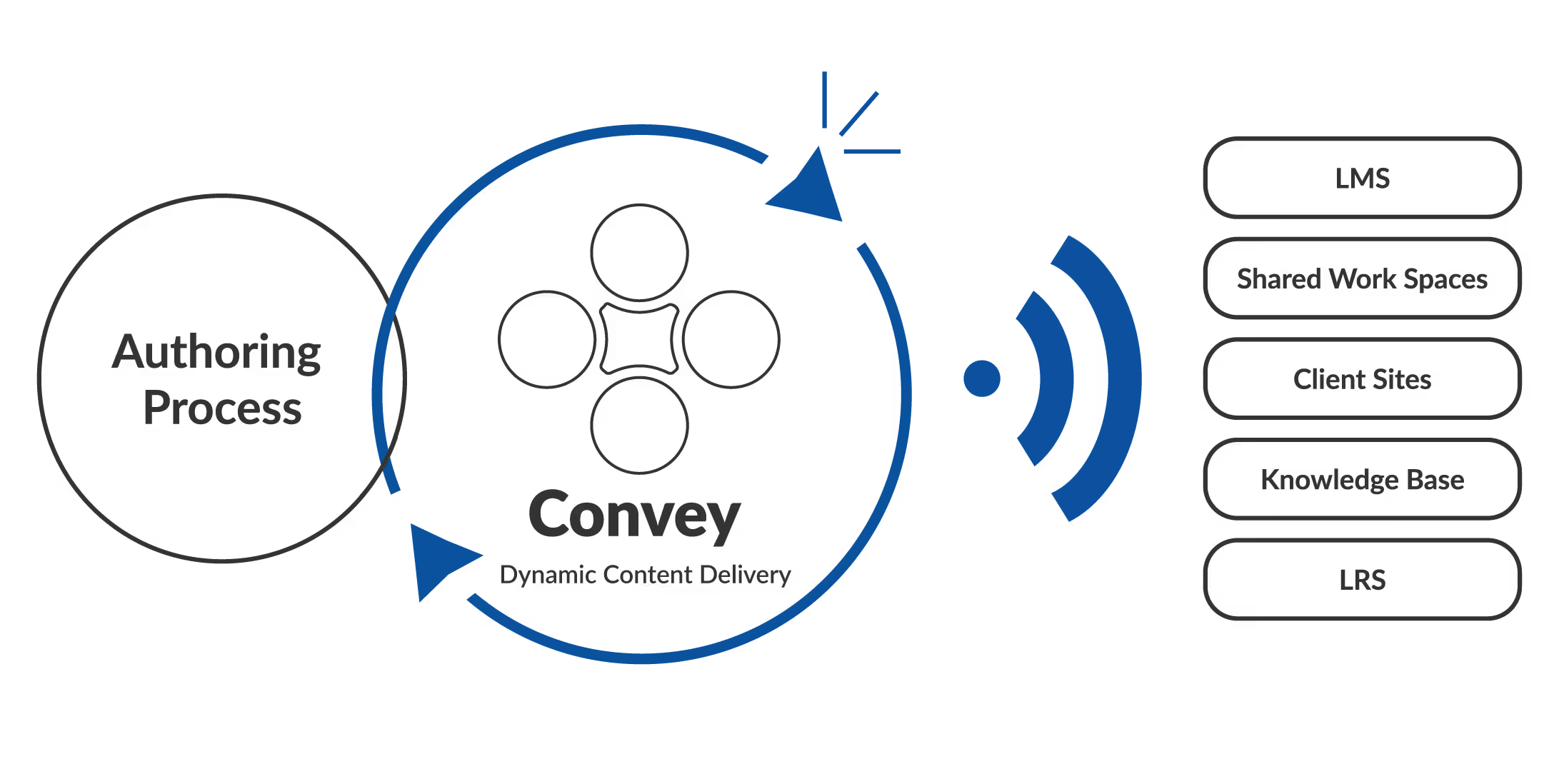Streamlining Your Learning Content Availability with Convey Dynamic Content Delivery




If you ask any L&D professional what takes up way more time than it should in the average week, many of them will say that it’s content maintenance. Whether that means populating the Learning Management System (LMS) with eLearning or tracking down every instance of an outdated job aid, it can take anywhere from days to weeks to find the content in question, update it, and get the right learning content in the right place.
For any learning team who struggles to distribute eLearning content – or redistribute it when it’s time to be updated – you’ll likely be looking for a way to accelerate the process and save yourself time and duplication of effort.
Traditionally, distributing learning content hasn’t been a quick or easy process.
Uploading brand-new content may not be too much of a hassle. Once you’ve identified where the eLearning needs to be uploaded, it’s usually pretty straightforward to upload the file to the platform (or platforms). It will then live happily on the platforms until the next content update is due.
There are all sorts of reasons you may need to update your eLearning content, including:
This is where the challenges start to creep in. Typically, an authoring team will need to submit a ticket to their LMS admin, who will then republish the updated document, and eventually reupload the updated content to the relevant locations.
Except… how can you be sure you’ve got a complete inventory of ALL the places you’re using that eLearning content? If it just lives on your LMS, maybe it’s easy enough, but what if it also lives in your internal folders, on your intranet, on your LXP… all of a sudden, fixing a simple typo becomes a lot more complex, and you can end up with inconsistencies across your learning offering, or a huge manual effort to replace every single instance of a resource.
Put simply, dynamic content delivery is a way to update source content once, and replace all existing copies at the touch of a button.
Think of it like the difference between a local Word document and Google Docs.
Microsoft Word files live locally on a device and need to be uploaded to specific folders, websites and platforms. When they’re downloaded to another device, the author loses control of that version, meaning outdated or inaccurate information lives on undetected, potentially for years.
Google Docs, on the other hand, live in the cloud. The author shares a link to their Google Doc with anyone who needs it, and the moment the author makes an update, everyone can see it in real time. A single Google Doc acts as the “master copy,” and as updates are made over time, anyone using that link will have access to the latest version, with no need to constantly upload or download files.
If traditional eLearning content distribution is like Microsoft Word, dynamic content delivery is like Google Docs.
Instead of uploading a specific file across multiple platforms, dynamic content delivery allows you to share a link (known as a “SCORM stub” or “web package”) to each platform. Every time you make an update to the original file, you can push the updates, with a single click, and every copy of the content is linked back to this update, saving you a huge amount of time and effort and avoiding the human errors that typically occur when you’re carrying out a major manual updating process. It also significantly boosts the ROI of the L&D team, as it allows them to spend their time on more useful tasks than simply reuploading static eLearning files.
A dynamic publishing service can reduce the time spent finding, posting, updating, and maintaining formal learning content by as much as 90%.
There are very few organizations using eLearning who wouldn’t benefit from the ease and efficiency of dynamic content delivery.
However, we’ve broadly identified two scenarios where it is especially useful.
If you’re an organization who relies on structured eLearning via LMS, dynamic content delivery is extremely useful when it comes to making the distribution of eLearning content significantly faster and easier.
The traditional process for uploading and updating eLearning on an LMS is:
With dynamic content delivery, you effectively skip the middle steps. The content author is empowered to make edits in collaboration with subject matter experts and compliance approvals asynchronously. Once updates to the eLearning are approved, they update the content themselves, and immediately make it available across all instances. Instead of waiting days or weeks for the LMS administrator to find time to address the ticket, changes can be made in moments, ensuring everyone has the most up-to-date, accurate information at all times with the least amount of administrative workload, focusing efforts on more critical tasks.

While this is useful for making large updates, such as adding new product information or amending industry regulations following a content audit, it really comes into its own for those tiny content edits that would otherwise take several days to fix. After all, why wait a week for the LMS admin to read the ticket, make the amends, reupload the updated file to the LMS when the content author can simply do it themselves in minutes?
Large, global organizations with multiple learning platforms will find this especially useful. Instead of wasting L&D’s time tracking down every version of a course, you can do it all in one go, potentially saving days of time.
Not every organization relies wholly, or in part, on an LMS – particularly smaller businesses, or those where desk-based roles aren’t the norm.
But just because you don’t have an LMS, that doesn’t mean you won’t have learning content. You may have job aids, performance support, instructor-led materials, or even standalone eLearning courses – they just won’t all live together on an LMS. They could be emailed out on an ad hoc basis, stored on SharePoint or be linked within other platforms, such as the CRM or HR system.
The content may appear less structured at first glance, but that doesn’t need to mean it’s harder to manage. Using the traditional method of uploading static files, it can quickly become a nightmare keeping track of everything, while dynamic content delivery, once again, allows the content author to identify previous versions that have been published and make updates to every instance in existence from a central control center.
This is especially useful for small organizations, who may not have access to a dedicated webmaster or content manager. Instead, the content author has the power to get new and updated content live instantly, without needing to rely on anyone else, making a small L&D team much more self-sufficient. Updating web experiences is possible thanks to the hosting server that comes standard with Convey. It provides a web-accessible destination for the content to be hosted outside of internal web properties, placing the control in the hands of the authoring team.

If you’re used to the traditional “uploading a SCORM file to your LMS” method of learning content distribution, you may be wondering how you can measure learning engagement with dynamic content delivery. After all, if learners are effectively accessing content via a link, how can you be sure who’s accessing it?
For organizations with an LMS, the good news is that it’s just as easy to access learning data from content delivered from a dynamic SCORM stub, as it is to see data for SCORM files uploaded to the LMS. The learner data can be accessed directly from the LMS as it would always have been. Additionally, through xAPI learning data can be captured by a Learning Record Store (LRS). In your LRS you can create data visualizations or even export this data into a Business Intelligence (BI) tool, such as Looker or Tableau for deep data analysis. With dominKnow | ONE data can be captured simultaneously in the LMS and LRS in real time, minimizing any extra export steps.
For businesses offering content outside of an LMS or LRS, it’s still possible to see the number of learners accessing a piece of online content, such as via your knowledge base or intranet. This helps you understand if the content is useful and being seen, and it can give you a basic understanding of the way learners are consuming your resources.
Convey is dominKnow’s dynamic content delivery tool. It streamlines the learning content distribution process by allowing your authoring team to quickly get content updates into your LMS (or other platforms) without the tedious administrative process of relying on specialist roles to publish content to their final destinations.
“Using dominKnow | ONE and Convey reduced content development time from 3-6 months to weeks. We used to spend 90% of our time maintaining content and searching for content requiring updates somewhere across our LMS or SharePoint workspace. Now we can update content instantly without having to track it down. Simple and efficient.”
- Ed Hjorth, Digital Content Lead, MicroFocus (an OpenText company)

With Convey, organizations of all sizes can significantly fast-track content distribution across their LMS, shared workspaces, client sites, knowledge base and LRS with no duplication of effort required. dominKnow | ONE’s learning content templates make it quick and easy to create learning once, then distribute it across multiple channels, and it can all be updated within minutes.
Convey synchronizes seamlessly with the dominKnow | ONE Learning Content Management System (LCMS). This means you can take advantage of the dominKnow | ONE single-source content approach, creating content once and spinning it into multiple formal and informal formats, then immediately publish changes to every single piece of content with just a few clicks in the authoring interface. This is ideal for everyone from one-person L&D teams to multinational organizations with multiple learning platforms and information destinations.
There are so many reasons to opt for dynamic content delivery, but if you’re struggling to visualize how it might work in your organization, let’s take a look at how other companies are using it.
A large financial institution needed a replacement for a legacy LCMS which could handle a high degree of customization and the ability to use HTML, JavaScript, and xAPI data. dominKnow | ONE was selected as a superior replacement to the client’s previous LCMS – in part because of its powerful content creation abilities, and in part because of the ease of distributing content with Convey.
The Convey dynamic publishing and hosting service allowed the client to provide a wide range of content to its learners through structured, formal self-study learning programs, which can be easily edited and updated in real-time without the need for uploading new SCORM files, and informal access to self-study learning programs. For the self-study programs, the client publishes the same courses to Convey as Public Share Links (instead of SCORM) to create website versions, with content updates automatically available when they are published to the same link.
“Convey was huge for us because we could make edits without having to replace and republish a SCORM file each time. If we had to replace a SCORM file, that was a multi-week process. Especially when it’s just to update a spelling error or something simple like that it was lengthy, and not cost-effective. Now, with dominKnow | ONE’s dynamic content delivery platform, Convey, we don’t have to go through that process.”
A market-leading software security client needed a way to educate external customers, including:
The client needed to reduce its production time while also ensuring that all content remained consistent and up to date, no matter where their customers accessed the learning.
The Convey dynamic content delivery tool allows the customer to deliver all three forms of learning. The client can publish courses within Convey, which then connects to the LMS for launching (and tracking where needed), along with website versions and a Knowledge Base, which acts as a performance support resource for all external customers. Thanks to Convey, they can easily make edits to content, such as when new software features are launched, and push them out to all relevant platforms for consistent, fully up-to-date learning.
“We’re doing things we didn’t think were possible. With dominKnow | ONE, we’ve increased our NPS score 30 points and significantly reduced our development time from 3-6 months to weeks! Now all of our users are getting consistent information wherever they are and most importantly, when they need it. Overall, dominKnow | ONE and Convey have changed how we create and deliver content.”
Ready to see Convey in action? We’d love to show you how quick and easy it can be to distribute your learning content, no matter how large or complex your course catalog may be. Schedule your demo today to see how Convey works!
.avif)
Instructional Designers in Offices Drinking Coffee (#IDIODC) is a free weekly eLearning video cast and podcast that is Sponsored by dominknow.
Join us live – or later in your favourite app!
Contact us for a free trial of Convey Dynamic Content Delivery